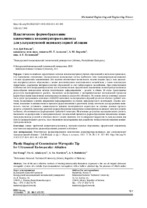| dc.contributor.author | Вэньци, Дай | |
| dc.contributor.author | Алексеев, Ю. Г. | |
| dc.contributor.author | Королёв, А. Ю. | |
| dc.contributor.author | Будницкий, А. С. | |
| dc.coverage.spatial | Минск | ru |
| dc.date.accessioned | 2021-04-07T10:12:03Z | |
| dc.date.available | 2021-04-07T10:12:03Z | |
| dc.date.issued | 2021 | |
| dc.identifier.citation | Пластическое формообразование наконечника концентратора-волновода для ультразвуковой эндоваскулярной абляции = Plastic Shaping of Concentrator-Waveguide Tip for Ultrasound Endovascular Ablation / Дай Вэньци [и др.] // Наука и техника. – 2021. – № 2. – С. 101-108. | ru |
| dc.identifier.uri | https://rep.bntu.by/handle/data/89977 | |
| dc.description.abstract | Одним из наиболее эффективных методов лечения внутрисосудистых образований в настоящее время является применение ступенчатых ультразвуковых волноводных систем трубчатого типа (концентраторов-волноводов) с полым сферическим наконечником. Его наличие обеспечивает возможность подачи жидких сред в зону дислокации внутрисосудистого образования с целью дополнительного кавитационного воздействия, а также максимально эффективное разрушение внутрисосудистых образований за счет виброударного воздействия. При существующих особенностях методов формообразования для получения полого сферического наконечника концентратора-волновода целесообразно использовать методы пластического деформирования – раздачу и обжим. В статье представлены результаты предварительного расчета, численного моделирования и экспериментальных исследований процессов формообразования наконечника концентратора-волновода раздачей и обжимом. На основе метода конечных элементов в среде программного комплекса ABAQUS выполнено моделирование операций раздачи и обжима трубной заготовки, позволившее: оценить напряженно-деформированное состояние деформируемого конического участка заготовки, изменение толщины стенки в процессе формоизменения и рассчитать длину заготовки для оформления конического участка; установить закономерности влияния геометрических параметров на силовые режимы процесса раздачи; установить параметры режимов формообразования наконечника концентратора-волновода методом раздачи и обжима, обеспечивающие формирование требуемой геометрии. Полученные результаты предварительного расчета, численного моделирования и экспериментальных исследований процессов формообразования наконечника концентратора-волновода раздачей и обжимом имеют схожие значения, что подтверждает корректность использования как метода предварительного расчета, так и численного моделирования при разработке технологии изготовления концентратора-волновода. | ru |
| dc.language.iso | ru | ru |
| dc.publisher | БНТУ | ru |
| dc.title | Пластическое формообразование наконечника концентратора-волновода для ультразвуковой эндоваскулярной абляции | ru |
| dc.title.alternative | Plastic Shaping of Concentrator-Waveguide Tip for Ultrasound Endovascular Ablation | ru |
| dc.type | Article | ru |
| dc.identifier.doi | 10.21122/2227-1031-2021-20-2-101-108 | |
| local.description.annotation | One of the most effective methods of treating intravascular formations at present is the use of stepped ultrasonic waveguide systems of a tubular type (concentrators-waveguides) with a hollow spherical tip, the presence of which makes it possible to supply liquid media to the dislocation zone of an intravascular formation with the aim of additional cavitation effect and as efficiently as possible. destroy intravascular formations due to vibration impact. Based on the results of the analysis on the features of the existing shaping methods for obtaining a hollow spherical tip of the concentrator-waveguide, it is advisable to use methods of plastic deformation – expansion and crimping. The paper presents results of preliminary calculations, numerical modeling and experimental studies of tip shaping processes of the concentrator-waveguide by distribution and crimping. On the basis of the finite element method in the environment of the ABAQUS software package, modeling of the expansion and crimping of a pipe billet was carried out, which has made it possible to: evaluate the stress-strain state of the deformable conical section of the billet, the change in wall thickness during the forming process and calculate the length of the billet for the design of the conical section; to establish the patterns of the influence of geometric parameters on the power modes of the distribution process; to set the parameters of the modes of forming the tip of the concentratorwaveguide by the method of distribution and crimping, which ensure the formation of the required geometry. The obtained results of preliminary calculation, numerical modeling and experimental studies of tip shaping processes of the concentratorwaveguide by distribution and crimping have similar values, which confirms the correctness of using both the method of preliminary calculation and numerical modeling in the development of the technology for manufacturing the concentratorwaveguide. | ru |

